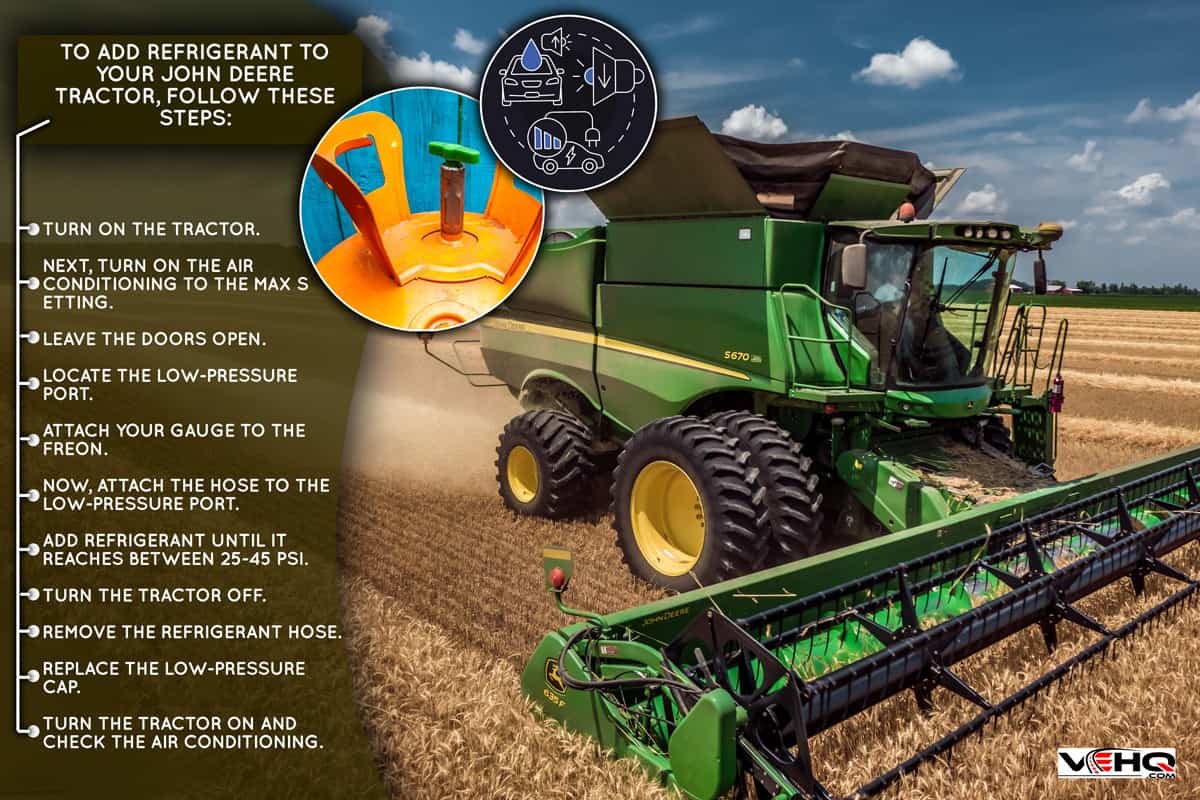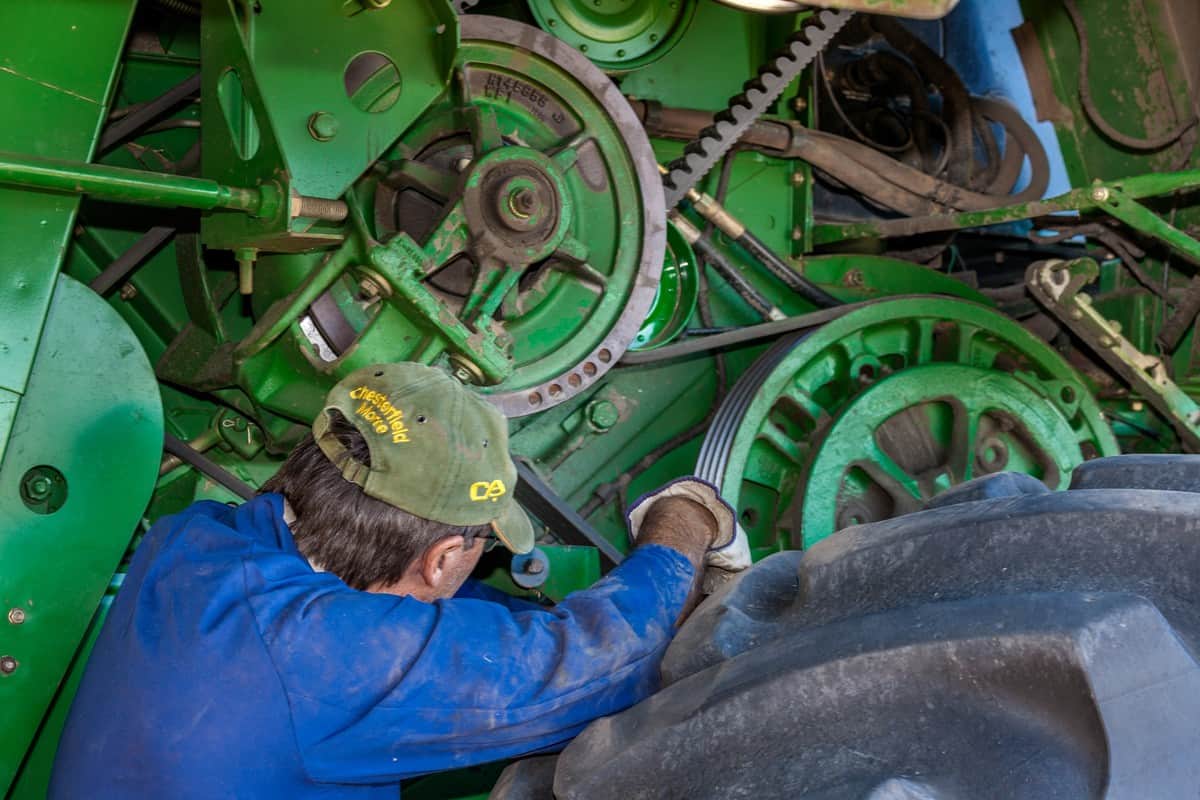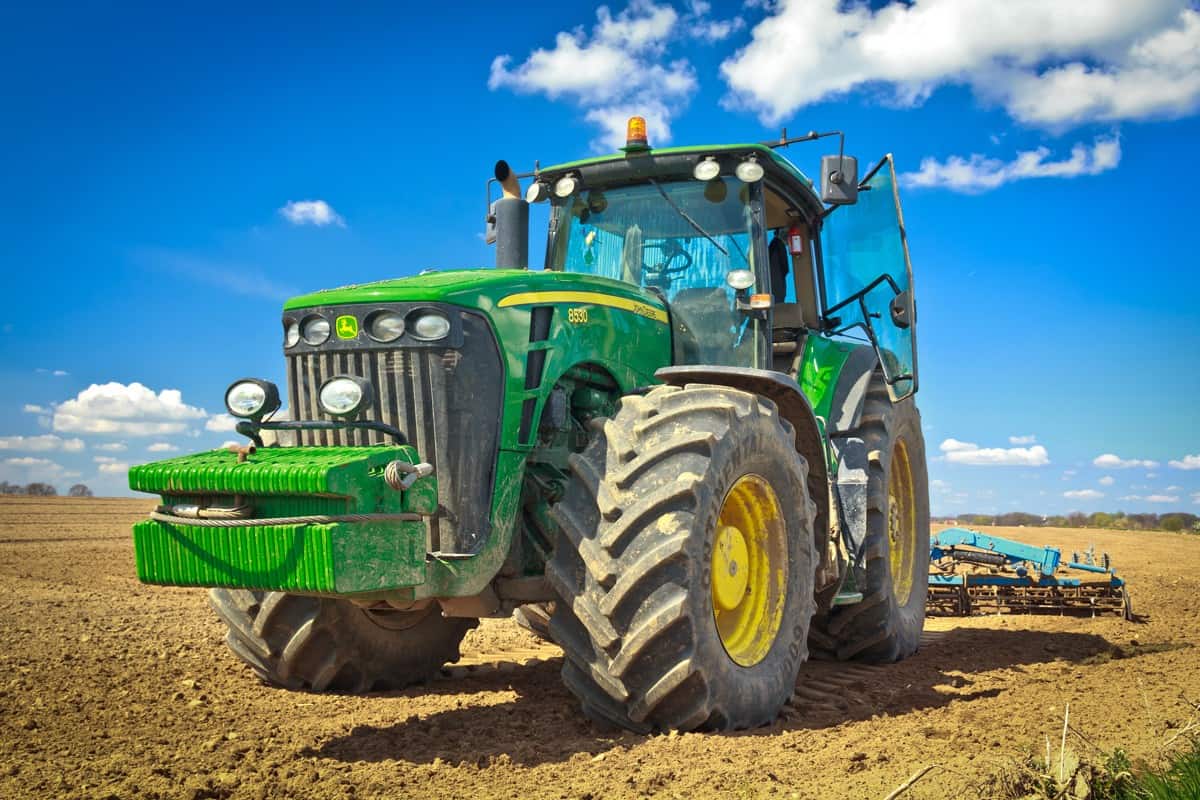When riding in your John Deere Tractor on a hot day, the air conditioning can make all the difference. But when the air conditioning is blowing warm, then more than likely, your tractor is low on refrigerant. Let's take a look at how to recharge the system.
To add refrigerant to your John Deere Tractor, follow these steps:
- Turn on the tractor.
- Next, turn on the air conditioning to the max setting.
- Leave the doors open.
- Locate the low-pressure port.
- Attach your gauge to the freon.
- Now, attach the hose to the low-pressure port.
- Add refrigerant until it reaches between 25-45 PSI.
- Turn the tractor off.
- Remove the refrigerant hose.
- Replace the low-pressure cap.
- Turn the tractor on and check the air conditioning.
As you can see, adding refrigerant to your John Deere tractor is pretty straightforward. Nonetheless, in this article, we will discuss each step in detail. In addition, we will answer other frequently asked questions about the air conditioning system in a John Deere tractor, so read on!

Steps To Adding Refrigerant To A John Deere Tractor
While it may not seem necessary, having air conditioning in your tractor can make a big difference, especially on those hot summer days. Being in a tractor without air conditioning can make for a long day.
However, it can frustrate when you turn on your air conditioning, only to have lukewarm air blow out. If this is happening, then it is likely that your John Deere tractor is low on refrigerant.
Luckily, recharging the system is a pretty simple process that anyone can do. All you need is a few supplies and to follow these steps:

Turn On The Tractor And Air Conditioning On Max
First, you will want to turn on the tractor. Then, you will want to turn the air conditioning to the max setting and open all the doors.
Opening the doors will ensure that the air conditioning doesn't cycle on and off. If the doors are closed, the air conditioning will turn on and off as it tries to reach the desired temperature, making adding refrigerant difficult.
Locate The Low-Pressure Port
The next step is to locate the low-pressure port. The low-pressure port is where you will be attaching your gauge and hose to add the refrigerant.
Typically, the low-pressure port is labeled with an "L." You can also usually find it on the larger of the two pipes leading from the air conditioning compressor.
If you are having trouble finding the low-pressure port, consult your John Deere tractor's manual.
Attach Your Gauge And Hose To The Refrigerant
Now, you can attach your gauge and hose to the refrigerant. Once it is attached correctly, you can attach the hose to the low-pressure port.
Be sure that you have a tight seal so that no refrigerant escapes while you are adding it.
Add Refrigerant Until It Reaches Between 25-45 PSI
Now, you can begin to add refrigerant. You will want to add it until the pressure reaches between 25-45 PSI.
When adding refrigerant, do it slowly. You will need to stop and check the pressure often.
If you add too much, then it can cause damage to your air conditioning system. Conversely, it won't be effective if you don't add enough.
Turn The Tractor Off And Remove The Refrigerant Hose
Once you have added the correct refrigerant, you can turn the tractor off. Then, you will want to remove the refrigerant hose.
Be sure to put the cap back on the low-pressure port so that no dirt or debris gets into it.
Turn The Tractor On And Check The Air Conditioning
You can turn the tractor back on and check the air conditioning. It should be blowing out cold air.
If it is not, you may need to add more refrigerant, or there could be another issue with your tractor's air conditioning system.
As you can see, adding refrigerant to your John Deere tractor is a pretty simple process. However, if the air conditioning still isn't blowing cold, then keep reading.
Why Is My A/C Not Blowing Cold On My John Deere Tractor?
Even after adding refrigerant, your John Deere tractor's air conditioning may still not be blowing cold. If this is the case, there could be a few different issues.
Let's take a look at common reasons why your tractor's air conditioning may not be working correctly:
The Air Conditioning Compressor Could Be damaged
If the air conditioning compressor is damaged, then it won't be able to compress the refrigerant vapor. This will prevent the refrigerant from becoming cold.
As a result, your air conditioner won't be able to blow out cold air. There are some signs that the air conditioning compressor is damaged, such as:
- Noises coming from the compressor.
- Leakage from the compressor.
- Refrigerant leaks.
- Stuck compressor clutch.
Checking the compressor is something that you will need to take your tractor to a John Deere dealer or certified technician.
Fail Reciever Drier
The receiver drier is similar to an air filter or oil filter. Its job is to remove any moisture or contaminants from the refrigerant.
If the receiver drier fails, it can allow moisture and contaminants into the system. These can cause corrosion and damage to other parts of the air conditioning system.
If you work in humid conditions, then receiver driers need to be replaced more often. You should also replace them if you notice any of these signs:
Bad Evaporator Coil
The evaporator coil is responsible for absorbing heat from the air inside the tractor's cab. If the evaporator coil is damaged, it won't be able to do its job correctly.
As a result, the air conditioning system won't be able to blow out cold air. There are some signs that the evaporator coil is damaged, such as:
- Tractor overheating.
- Bad smells coming from the air conditioning vents.
- Warm air coming from the air conditioning vents.
- Frozen evaporator coils.
If you suspect the evaporator coil is damaged, you will need to take your tractor to a John Deere dealer or certified technician.

Refrigerant Leak
If there is a refrigerant leak, then it can cause the John Deere tractor's air conditioning to stop working. You should check for any signs of a refrigerant leak, such as:
- Low refrigerant levels.
- Ice or frost on the refrigerant lines.
- Leaking from the air conditioning system.
It's best to have a mechanic find the source of the leak and repair it.
Faulty Expansion Valve
The expansion valve is responsible for regulating the flow of refrigerant. If it is damaged or not working correctly, then it can cause the air conditioning system to stop working.
Some signs that the expansion valve is damaged or not working correctly are:
- Inconsistent airflow.
- Frost on A/C vents.
- A/C compressor always running.
If you see these signs, you must take your tractor to a John Deere dealer or certified technician.
How Much Does It Cost To Fix Air Conditioning On A John Deere Tractor?
The cost of repairing the air conditioning on a John Deere tractor will depend on the issue. Some repairs, such as adding refrigerant, can be done relatively cheaply. However, you could pay close to $1,000 for some repairs.
Other repairs, such as replacing the compressor, can be much more expensive. The best way to get an accurate cost estimate is to take your tractor to a John Deere dealer or certified technician.
They can then pinpoint the problem and give you an estimate of the cost of repairs. Nonetheless, start with the inexpensive troubleshooting options.
This includes checking the refrigerant levels and checking for leaks. These are relatively easy and cheap fixes that could get your air conditioning working again.

What Happens If You Add Too Much Refrigerant To A John Deere Tractor's AC?

Adding too much Freon to a John Deere tractor's air conditioning system can cause the system to overheat. This can damage the compressor and other parts of the system.
The reason being is that the excess refrigerant could flood the compressor. As a result, it can't properly compress the refrigerant. This increases the temperature inside the compressor and can cause it to fail.
This is why paying attention to the gauge when adding Freon to the system is vital. You should only add enough to reach the green zone on the gauge.
Final Thoughts
While adding refrigerant to your John Deere tractor isn't challenging, you still need to be careful. Check for leaks and pay attention to the gauge when adding Freon.
If you're unsure about anything, it's best to take your tractor to a John Deere dealer or certified technician. They can properly diagnose the problem and make the necessary repairs.
Made it to the end? Here are other articles you might enjoy:
What Year Is My John Deere Tractor? [Inc. VIN Chart]
John Deere Tractor Won't Start Just Clicks—What Could Be Wrong?
Kubota Tractor Won't Start Just Clicks – What Could Be Wrong?
